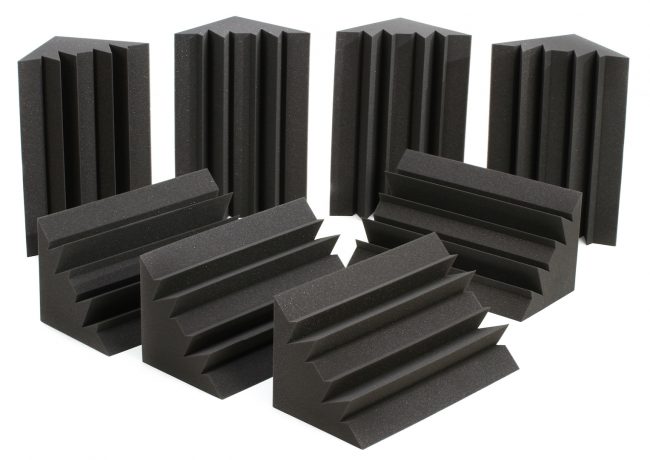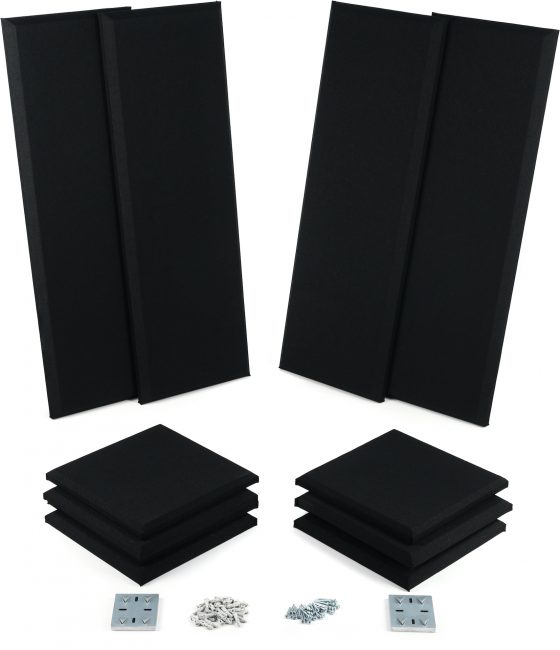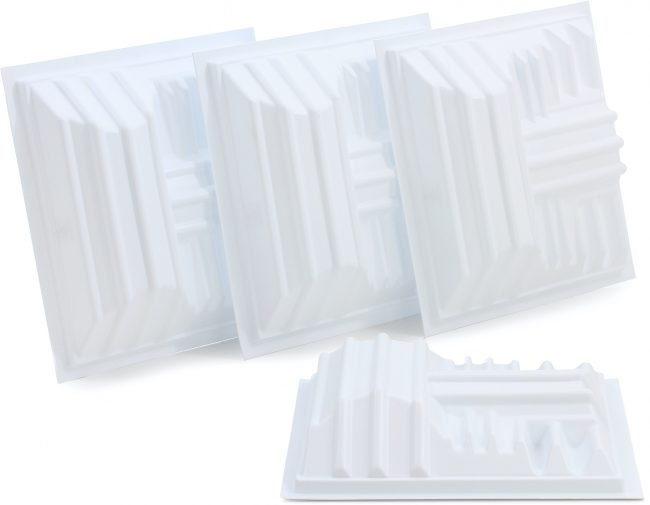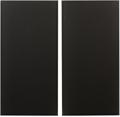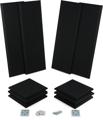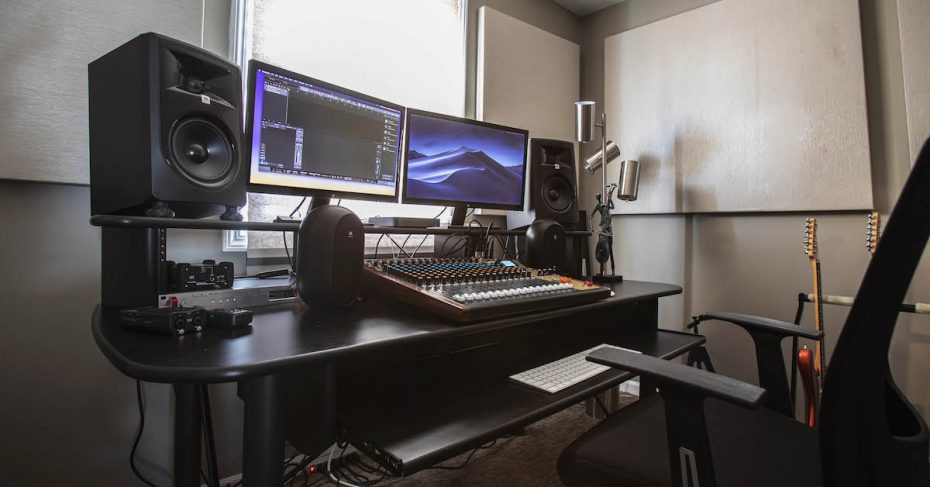
Once you’ve mixed your music in your home studio, does that mix hold up when you listen to it out in the real world? Or, do you find yourself making numerous mix revisions until it sounds equally acceptable in your car, on your phone, and through your TV? If you’re struggling to make your mixes translate to other playback systems, it’s likely that you’re fighting with the acoustics in your room. Most musicians and producers understand that the acoustics of your mix space will affect how you mix, but it’s not always clear how to improve the acoustics in your home studio. Let’s look at some basic acoustic treatment solutions you can use to solve common sonic problems and achieve better mixes as a result.
Studio Monitor Placement
A smart way to begin improving the acoustics in your mixing space should be making sure your monitor speakers are aligned and positioned correctly. Try starting with your monitors at least 3′ away from walls to decrease the boundary effect. When you’re sitting in your mix position, your head and your studio monitors should form an equilateral triangle with the tweeters at ear level. If you can, place your monitor speakers on speaker stands — placing them on a desktop can introduce reflections off the desk surface, which can cause a comb-filtering effect at your mix position. Learn more from an expert in Mitch Gallagher’s article “Maximizing Your Studio Monitors.”
Problem #1: Your mixes have weak, muddy, or unbalanced bass
One of the most common problems musicians have with home studio mixes revolves around the bass region. Specifically, the bass content in the mix sounds weak, boomy, muddy, or indistinct when the mix is played outside of your mixing space. Without getting into the details of how room dimensions affect how you hear things, most home studio spaces will have big sonic irregularities in the 20Hz–300Hz region, including narrow-band buildups and cancellations that prevent you from accurately analyzing the lowest octaves of your mix. These can cause your mixes to have less bass power than they need, while your room is telling you the bass sounds full and strong. The reverse can happen, too — you can mix with too much bass if your room happens to be nulling certain bass frequencies, muddying the entire low end of your mix.
Solution: Add bass traps
Bass abnormalities are created in your room due to excessive bass energy buildup, and it’s especially noticeable near the corners of your room. Bass traps come in a variety of designs, but at their core, they’re designed to do one thing — absorb as much sonic energy as possible in the bass octaves. Adding bass traps to your studio space is one of the biggest sonic improvements you can make — especially if your studio monitoring includes a subwoofer. Cleaning up the bass response of your mixing space makes it easier to ascertain what’s going on with the mids and highs in your mixes, too.
When you control the bass in your room, you’ll reduce your need to turn to EQ to make your mixes sound clear and powerful. And because you’ll be able to more accurately analyze the bass regions of your mix, your carefully crafted low end should translate better to other playback systems.
Some examples of popular bass traps:
Problem #2: Your mixes exhibit indistinct midrange or lack of depth
Mixes with an indistinct, congested midrange are another common product of mixing in a less-than-sonically-ideal home studio. When you combine elements like guitars, piano or synths, and vocals, you have a lot of midrange content fighting for the same frequency space. And just as with bass frequencies, your room can trick you into thinking certain frequencies are either more or less prominent than they really are in your mix. This is especially troubling when it comes time to fine-tune a focal point of your mix, such as the lead vocal or a guitar solo — the sonic inaccuracies of your room will negatively inform the choices you make with compressors and equalizers. The result can be a mix with poorly defined midrange elements and, possibly, a general lack of depth.
Solution: Add broadband absorption panels
Many midrange issues in a home studio are caused by parallel walls, which create standing waves that generate frequency-specific boosts and dips throughout your room. Parallel walls can also create flutter echo, which negatively affects your ability to dial in the right amount of reverb in your mix. The midrange issue is similar to that discussed in the bass section above — a buildup of excessive sonic energy makes you hear your mix less accurately. And, as with bass, the solution is to use sound absorption products tuned to midrange frequencies. The absorption characteristics of these panels generally cover low-mid, mid, and upper-mid frequencies, so they’re often referred to as broadband absorption.
Placed near your monitor speakers, broadband absorption panels will reduce reflections off the walls near your monitors. Placed elsewhere in your room, broadband acoustic panels will break up standing waves and flutter echoes that can still affect what you hear in your mix position. By controlling the midrange energy in your room, you’ll be able to more accurately process instruments and vocals in your mix using EQ, compression, and reverb. And, by achieving a better midrange mix, your music will sound better on midrange-focused playback systems such as phones, tablet computers, and TV speakers.
Some examples of popular broadband absorption solutions:
Problem #3: Your mixes lack definition and width
If your mixes sound bright, lively, and detailed in your studio but sound dull or poorly defined everywhere else, the high-frequency response of your mixing space is likely the culprit. High frequencies are much more directional than midrange and bass frequencies. Due to the way they bounce around your room in a beam-like manner, the high-frequency response will vary greatly around your room (even standing up can be a big change compared to what you heard while seated). But just like with bass and mids, if your room doesn’t provide an even, balanced high-frequency response, that will lead you into making poor mix decisions. Mixes that are too dull or too bright, or that have a too-narrow or too-wide stereo width, can be the result of poor high-frequency presentation in your room.
Solution: Add high-frequency diffusion
While bass and midrange problems are best solved by absorbing excess energy, high frequencies are best dealt with by scattering them — simply absorbing them would create a dull, lifeless listening zone that would negatively affect your mixing space further (in other words, don’t just cover every inch of wall space with absorption panels and call it a day). We rely on high frequencies to help us define sounds and their places in the stereo field. Diffusors are designed to scatter those directional beams of high-frequency energy more widely, balancing the response of your room while improving the sonic accuracy at your mix position. Placed on the sides and rear of your room, diffusors help to even out the high-frequency response throughout the room. Placed above your mix position, diffusors will break up directional early reflections from your speakers, allowing you to make more accurate mix decisions.
Some examples of popular diffusion products:
- Auralex T’Fusor 3D Sound Diffusor
- Acoustical Fulfillment Flex-48 Adaptive Treatment System
- pArtScience 3 inch SpaceArray Diffusor 2 x 2 foot Wood Panel (2-pack)
Explore Diffusion Acoustic Treatment
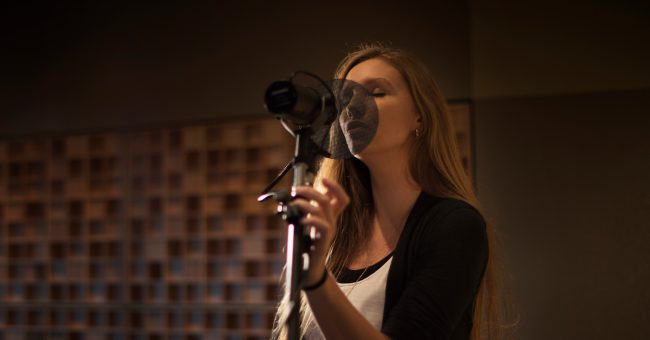
“Where do I place this stuff for the best effect?”
Absorption and diffusion won’t do you much good if you don’t place these solutions in the appropriate places in your studio. We’ve given some vague direction above, and that’s because the specifics of where to place acoustic treatment in your room are unique to your space. Sweetwater has long partnered with Auralex — leaders in the field of acoustic treatment — to offer our customers free room analysis and placement advice. It’s easy: simply fill out the Auralex Room Analysis form here and send it to your Sweetwater Sales Engineer. We’ll work with Auralex to review the specifics of your studio, and then we’ll contact you to go over the results. Through this professional analysis, you’ll learn which frequencies are building up or being nulled in your room, and you’ll have expert advice on where exactly to place room treatment products for the best results. Having your room’s acoustics analyzed by the experts at Auralex is easy: it’s free and will save you a lot of time and energy.
Learn more with Sweetwater’s expert advice
When it comes to the larger topic of acoustic science and how it applies to your home studio, I’ve barely even scratched the surface here. You can learn more about how to make your recording space sound great in this article called “How to Make Your Recording Space Sound Great” by Mitch Gallagher. For tips on improving your existing monitoring, check out Lynn Fuston’s “Studio Monitor Placement – 5 Tips for Optimal Sound.” If you’re not sure what the difference is between acoustic treatment and soundproofing, read this article. For more info on various acoustic treatment products, check out our “Acoustic Treatment Buying Guide.” And, if you’d like to speak to an acoustic treatment expert that understands the challenges of mixing in a home studio, give your Sweetwater Sales Engineer a call at (800) 222-4700 and we’ll be happy to advise you.


